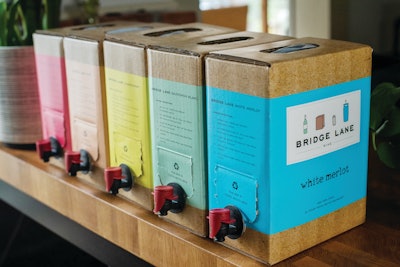
But Lieb Cellars, based in Suffolk County, N.Y., says that shouldn’t be the case. The brand is demonstrating that premium wine can also be packaged in alternative packaging formats, like flexible bag-in-box, cans, and even kegs too. Lieb Cellars offers six wine varietals of its Bridge Lane label in 3-L bag-in-box packaging, supplied by Rapak®, part of TriMas Packaging. The company says this flexible packaging solution is not only a more sustainable and cost-effective alternative to glass bottles, but it also protects the wine optimally in the many-touch world of e-commerce and extends the product’s shelf life. This is important since the winery has experienced increased demand from the e-commerce sector, particularly after the onset of the pandemic.
“This type of packaging is easier to handle in terms of logistics,” says Ami Opisso, General Manager at Lieb Cellars. “It not only requires less sourcing of materials than bottled wine [bag and corrugated only vs. bottle, label, corrugated, and cap], but glass bottles can break during shipment to direct-to-consumer (D2C) customers. With bag-in-box, we see almost no breakage.”
Still, the company quickly realized that it was not satisfied with the quality of its former bag supplier. So Lieb Cellers turned to Rapak, which offers a wide range of barrier film technologies to protect liquids from UV light and oxidation. Films include multi-layer coextruded oxygen and moisture barrier films, laminated high performance metalized substrates, and the newest product offering, a coextruded Nylon-EVOH film available in 1.5-L, 3-L, and 5-L sizes.
“We understand how important the shelf life of premium wine products is. For Lieb Cellars, we used a specially designed Nylon-EVOH coextruded film for their bag-in-box solution, which provides excellent oxygen barrier and high puncture resistance,” says Ken Micnerski, Retail Channel Manager, Wine and Oil, at Rapak.
The bag-in-box wine format compares favorably to bottled wine in other respects, too, according to Rapak. The product contact surface of the film was designed to be taste-neutral and retain the important aromas and notes of the wine. The film was also engineered with the best flex crack resistance to protect the high-quality product during transport. The film in combination with the iTap dispensing tap, a high flow one or two finger dispense tap, provides excellent oxygen barrier, good directional flow, and easy dosing by the consumer. With bag-in-box, wine remains fresh even four to six weeks after opening.
Sustainability was another consideration in choosing this particular bag-in-box application. In 2018, Lieb Cellars became certified sustainable by Long Island Sustainable Winegrowing, and packaging wines in eco-friendly containers, like bag-in-box, that greatly reduces carbon footprint, is an important initiative. Bag-in-box weighs less than a glass bottle, so up to 20% in energy costs can be saved during transport. The box is made of cardboard and is therefore 100% recyclable.
“These are the same high-quality wines that our customers have come to know and love in glass bottles. But with the new packaging solution, they can pour themselves a glass of wine on day one and, thanks to the dispenser and product-protecting film, it still tastes fresh after 30 days,” Opisso concludes. “We are very pleased that the collaboration with Rapak has been so successful.”























